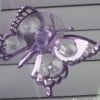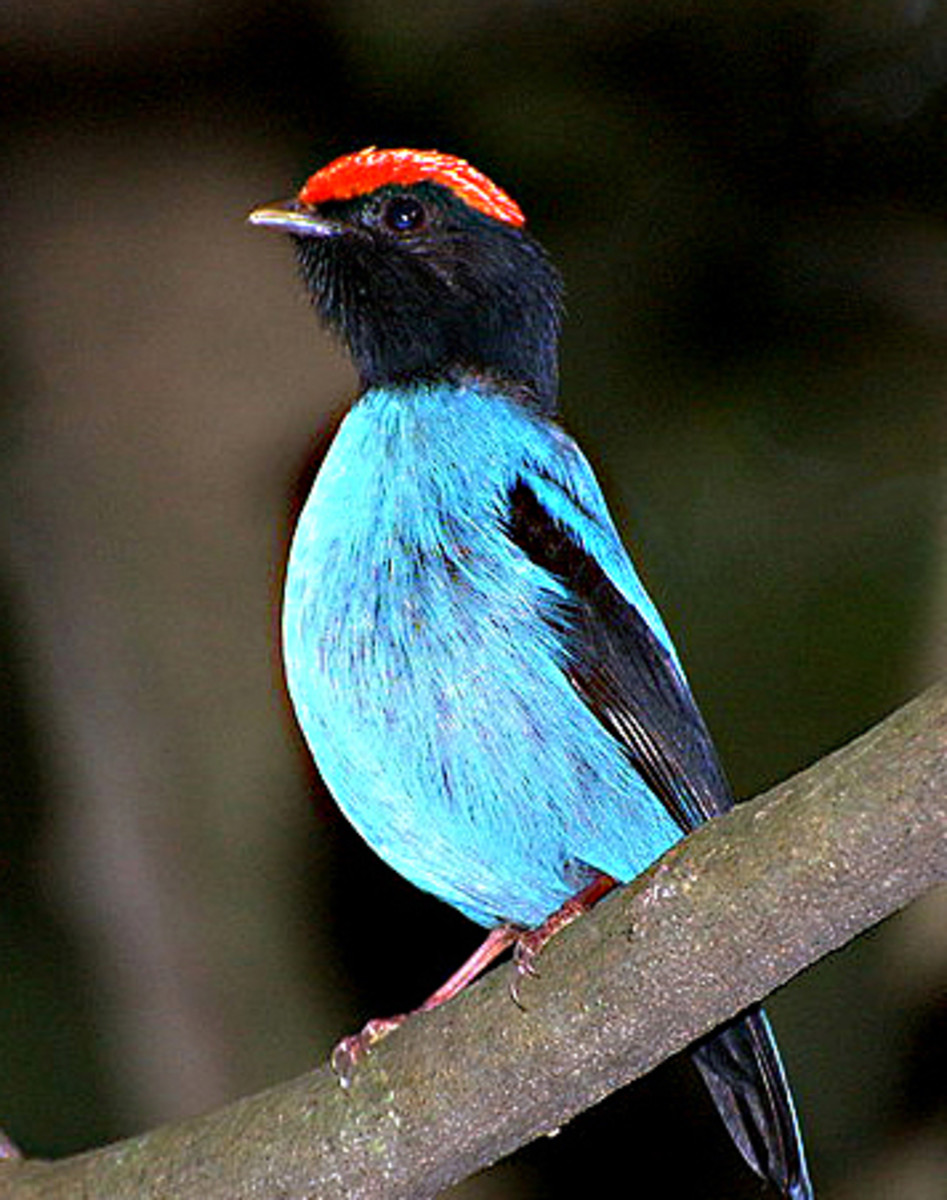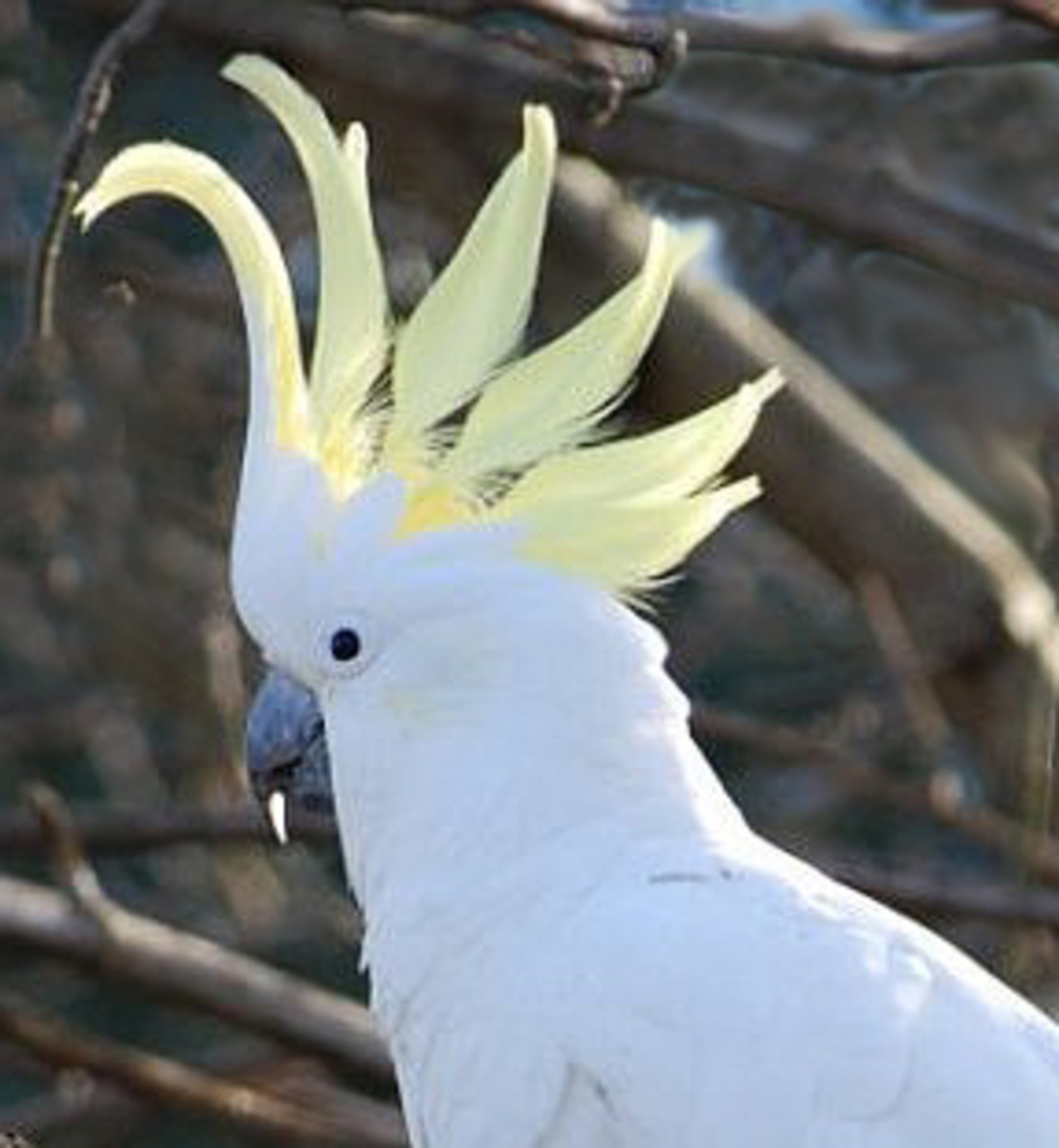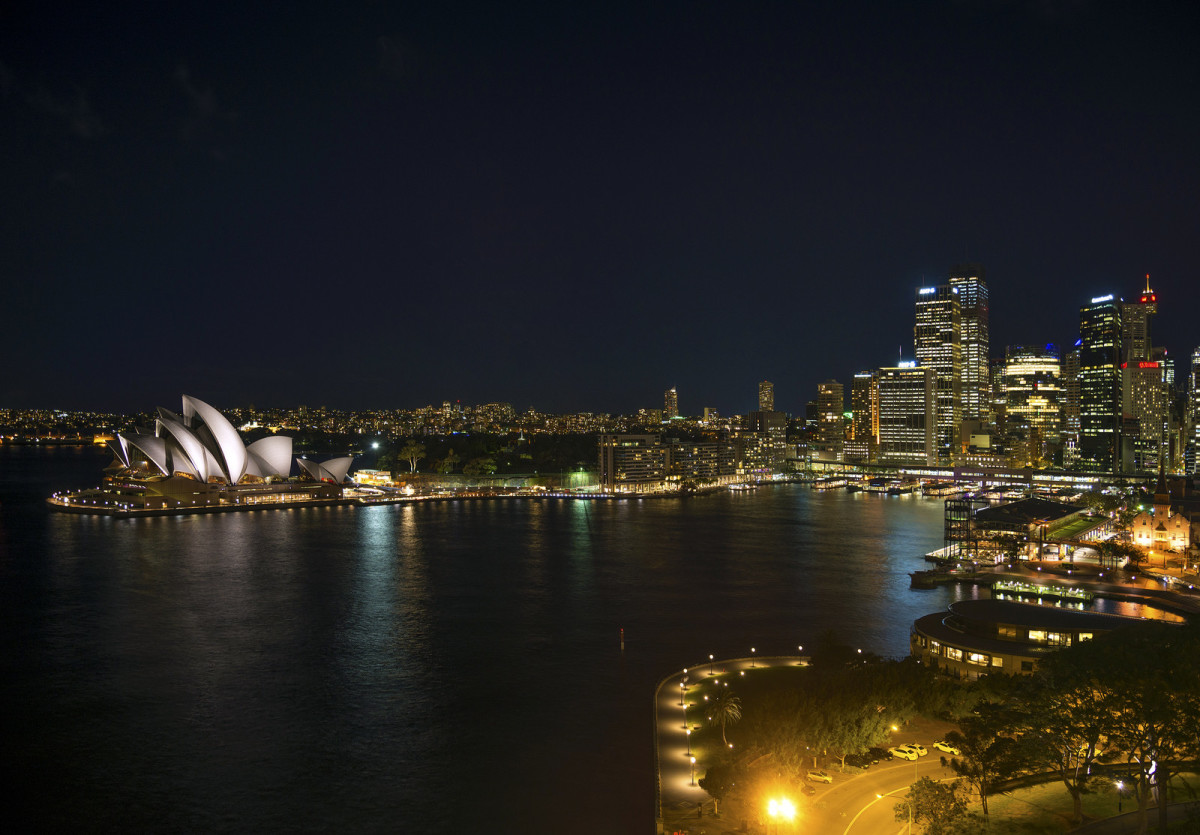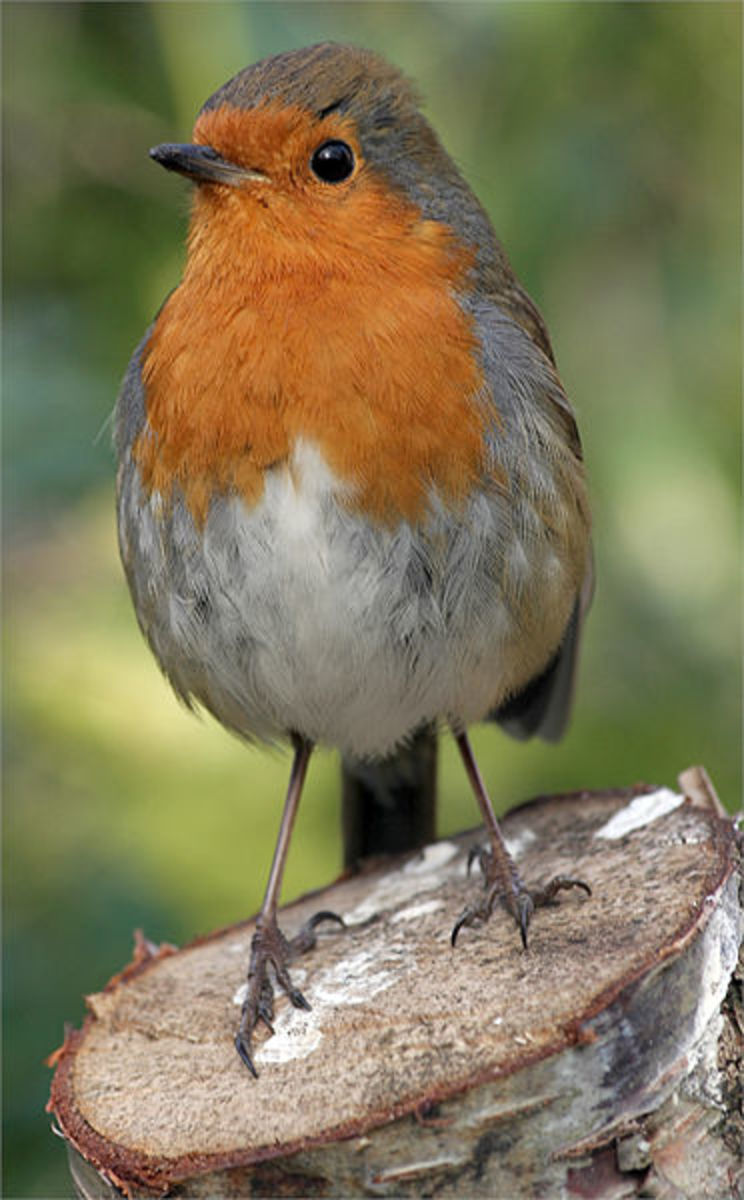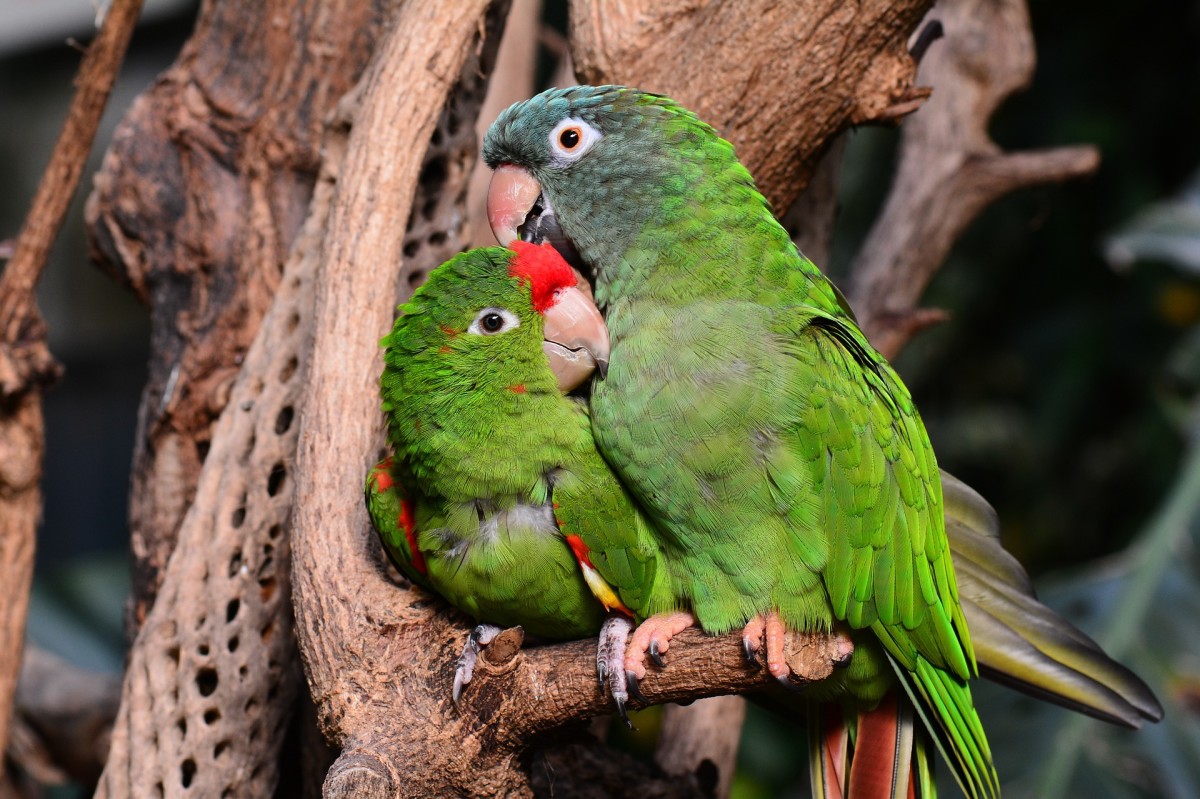Small Birds of the Australian Tropical Rainforests
Tropical north-eastern Queensland has long been recognized as one of Australia's richest bird habitats. Here occur birds that are more in keeping with the jungles of New Guinea than the largely arid Australian mainland. It is only in this small north-eastern corner, with its unique combination of tropical climate and close proximity to the far more extensive rainforests of New Guinea, that Australians can get a glimpse of such exotic creatures within their own continent.
Of the world's birds, the birds of paradise have more than any other held man's fascination for their incredibly beautiful, but often bizarre plumage. The family Paradisaeidae includes the riflebirds and manucodes. Australia has but four of these: Victoria's riflebird (Ptiloris victoriae), magnificent riflebird (P. magnificus), paradise riflebird (P. paradiseus), and the trumpet manucode (Manucodia keraudrenii). Only the paradise riflebird does not occur in the north-east, but it is an inhabitant of the subtropical and temperate rainforests that straddle the border between Queensland and New South Wales.
Distribution
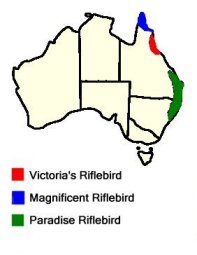
Victoria's riflebird
Named after Queen Victoria, and just 23-25 cm long, these are the smallest of the Australian riflebirds. As well as insects, they feed mainly on fruit, some of which they peel by holding it with one foot and removing the skin with their bill. The female is predominantly brown above with pale eyebrows, and has paler buff underparts faintly speckled with brown. The male is an overall black, subtly shot with an iridescent purple sheen that tends more toward blue-green on the head and bronze on the lower breast. His throat is a velvety black with a metallic green and blue triangular patch in the centre.
When the male begins to display, he erects the feathers of his throat and sides to accentuate the bright colors of his plumage in the shafts of sunlight that pierce the dimness of the rainforest. He curves his rounded wings above his body and tilts his head back to expose his chin and throat to the light, and then moves from side to side.
The female is attracted to the male's display post by his raspy 'yaars' call, which becomes softer and more melodious as the display progresses. The pair then face each other, and each bird raises and extends its wings forward alternately in an increasingly rapid rhythm. Finally, the male embraces the female with both wings, and copulation follows.
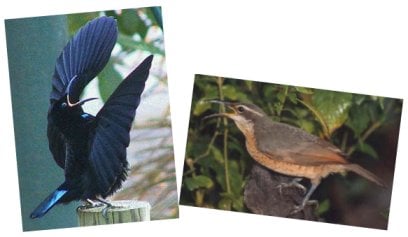
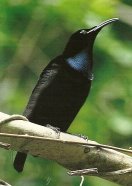
Magnificent riflebird
In the silence of the rainforest, the loud whistling 'weee-o' calls of magnificent riflebirds often betray their presence as they search in ones or twos for small invertebrates, fruits and seeds. They grow to about 28-33 cm long, with males being larger than females.
Like the other two Australian riflebirds, the male has iridescent black plumage, but the metallic greens, purples and blues extend further down his breast than they do in the other two species. The female bird is grey-brown above, and her underparts are a paler cream-buff with regular fine black barring.
The male's favoured display perch is generally a sunlit branch high in the rainforest canopy. He does not vocalise during courtship but stands erect and rapidly opens and shuts his wings, making a loud rustling sound. Sometimes he walks in a circle with his wings outstretched. When a female arrives, he stands with his tail cocked and wings and head back to display his magnificent throat and breast.
Paradise riflebird
This is the only bird of paradise to occur south of the Tropic of Capricorn. The loud 'yaass-a-yaass-aass' call of the paradise riflebird is made by both sexes, but especially by the male in breeding season, when it attracts mates by calling from an exposed perch high in the rainforest canopy and curving his wings up and tilting his head in the typical riflebird display posture. He then sways his body in a circular motion, so that his iridescent throat colors catch the light, and claps his wings together so loudly that the noise can be heard up to 60 metres away. When a female approaches, the male encircles her with outstretched wings and claps the tips together repeatedly as he dances backwards and forwards and around her.
Paradise riflebirds are 27-29 cm long. Males have the usual glossy black plumage; females are predominantly olive brown, with reddish brown wings and buff-cream underparts scalloped with darker brown.
Paradise riflebirds are common in their range but generally difficult to find; their calls or the loud rustling of their wing feathers as they fly from tree to tree are the best indicators of their presence. At times they feed in association with other fruit-eating species such as bowerbirds.
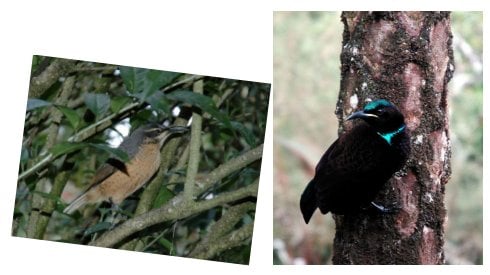
Distribution
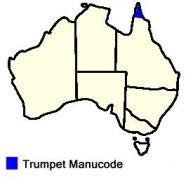
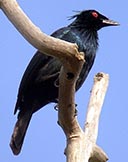
Trumpet manucode
The trumpet manucode is 27-32 cm long. Both sexes are black with a greenish-blue iridescent sheen to their feathers, and have bright red eyes. They have hair-like plumes - which grow longer in the male - on their nape and neck and behind their eyes, and long rounded tails. They feed mainly on rainforest fruits - particularly figs - although they also glean insects from the foliage.
These birds are most conspicuous during the breeding season, which extends from October to February. Males are territorial, and advertise from high perches with a single, trumpet-like call interspersed with occasional loud croaks. Courtship begins with the male chasing the female. From time to time both birds land on high perches where they face each other, the male crouching with feathers fluffed out and wings outspread.
There are records of the trumpet manucode migrating north, probably to New Guinea, but the remoteness of the bird's rainforest habitat makes close study of its habits difficult.
Probably the easiest of the northern species to see is Victoria's riflebird, at such places as Lake Eacham, Lake Barrine and The Crater National Parks. The magnificent riflebird and the trumpet manucode are found only towards the northernmost tip of Cape York Peninsula.
Of the world's nineteen species of bowerbirds, Australia has eight, with six species occurring in the tropical rainforests of the north-eastern corner. Of these, one of the most interesting is the golden bowerbird (Prionodura newtoniana).
Distribution
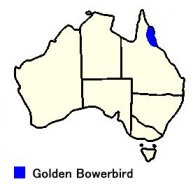
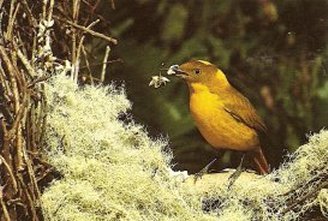
Golden bowerbird
Although it is Australia's smallest bowerbird, it builds the largest bower, which differs from all other bowers in being Australia's only example of the 'maypole' type of construction. The male golden bowerbird finds two small trees about a metre apart with a branch between them, which he later uses as a display perch. He then piles twigs up both uprights and decorates them with mosses, flowers, and fruits. The same bower is used year after year, and it can grow to over 3 metres tall.
Golden bowerbirds grow to about 25 cm long. The males have golden underparts and an olive brown back and wings; the females are olive brown above and dusky grey beneath, with indistinct markings on their throat and breast. Both sexes have yellow irises - the female's less bright than the male's - and both are accomplished mimics.
The female builds her nest in the crevice or fork of a tree trunk. The one or two eggs she lays hatch after about three weeks, and the young birds leave the nest about three weeks later.
Distribution
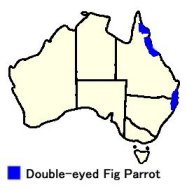
Very few of Australia's many species of parrots have become rainforest birds. One that has become a specialist of this habitat is the double-eyed fig-parrot (Cyclopsitta diophthalma).
In times past, three Australian fig-parrots were given full species status, but now they are regarded as races of the double-eyed fig-parrot of New Guinea, but they are sometimes given their own common names - Marshall's, McLeay's and Coxen's fig-parrots. Two of the three races occur in north-eastern Queensland. Marshall's fig-parrot (race marshalli) is found in the north-east of Cape York Peninsula, around the Claudie River district. The red-browed fig-parrot (race macleayana) inhabits the north-eastern coastal mountain rainforests from Cooktown at the base of Cape York Peninsula, southward almost to Townsville. The third, the blue-browed fig-parrot (race coxeni), was found further south, around the Border Ranges area of New South Wales and Queensland, but no one has recorded it in over three decades. It may be extinct, since much of its rainforest habitat has been cleared.
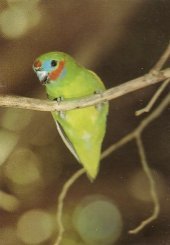
Double-eyed fig-parrot
At just 13 cm long, this bird is Australia's smallest parrot. It is bright green and has a plump, short-tailed body. Only the male has bright red ear patches. In one of its many color forms this parrot has a spot close to each eye, so that it seems to have four eyes; it is these markings that have given rise to its common name, but none of the Australian forms has this feature.
The main food of fig-parrots is native fig seeds, which they extract with their large bills. Although noisy in flight, these birds are much less vocal when feeding. Because they are not easy to observe in the canopy of tall rainforest trees, they are among Australia's least known parrots.Their nest is a hollow (usually drilled by the parrots) in the soft wood of a dead limb of a rainforest tree.
Photo Credits
Photos of the male and female paradise riflebird taken by Ken Clifton for ozanimals.com.
More information
- Lake Eacham Bird Species (PDF)
Lake Eacham Bird Species. Bird list research by Tablelands National Park. Volunteers with additional records from BANQ. Produced for BANQ by Elinor Scambler ... - Lake Barrine Bird Species (PDF)
Lake Eacham section of Crater Lakes National Park. Lake Barrine walking tracks allow birdwatchers ready access to view sought-after Wet Tropics ...
